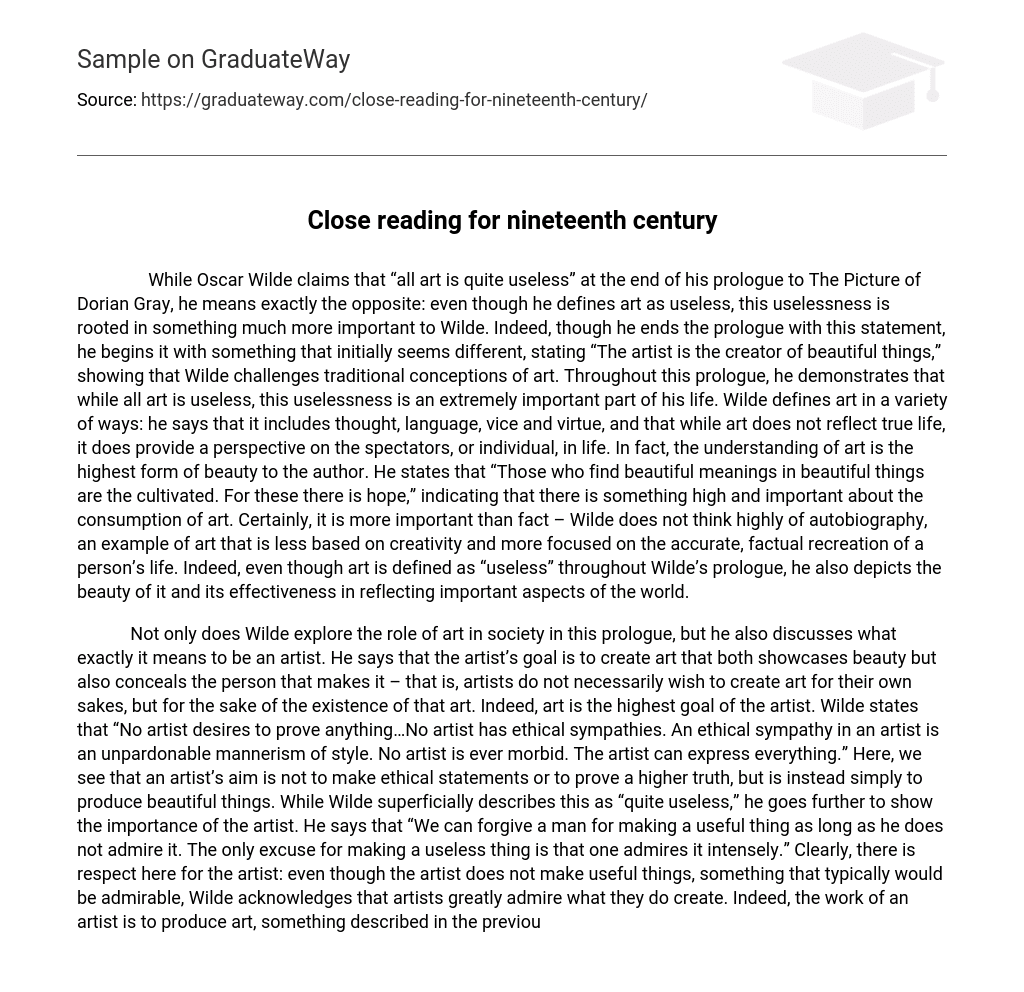While Oscar Wilde claims that “all art is quite useless” at the end of his prologue to The Picture of Dorian Gray, he means exactly the opposite: even though he defines art as useless, this uselessness is rooted in something much more important to Wilde. Indeed, though he ends the prologue with this statement, he begins it with something that initially seems different, stating “The artist is the creator of beautiful things,” showing that Wilde challenges traditional conceptions of art. Throughout this prologue, he demonstrates that while all art is useless, this uselessness is an extremely important part of his life. Wilde defines art in a variety of ways: he says that it includes thought, language, vice and virtue, and that while art does not reflect true life, it does provide a perspective on the spectators, or individual, in life. In fact, the understanding of art is the highest form of beauty to the author. He states that “Those who find beautiful meanings in beautiful things are the cultivated. For these there is hope,” indicating that there is something high and important about the consumption of art. Certainly, it is more important than fact – Wilde does not think highly of autobiography, an example of art that is less based on creativity and more focused on the accurate, factual recreation of a person’s life. Indeed, even though art is defined as “useless” throughout Wilde’s prologue, he also depicts the beauty of it and its effectiveness in reflecting important aspects of the world.
Not only does Wilde explore the role of art in society in this prologue, but he also discusses what exactly it means to be an artist. He says that the artist’s goal is to create art that both showcases beauty but also conceals the person that makes it – that is, artists do not necessarily wish to create art for their own sakes, but for the sake of the existence of that art. Indeed, art is the highest goal of the artist. Wilde states that “No artist desires to prove anything…No artist has ethical sympathies. An ethical sympathy in an artist is an unpardonable mannerism of style. No artist is ever morbid. The artist can express everything.” Here, we see that an artist’s aim is not to make ethical statements or to prove a higher truth, but is instead simply to produce beautiful things. While Wilde superficially describes this as “quite useless,” he goes further to show the importance of the artist. He says that “We can forgive a man for making a useful thing as long as he does not admire it. The only excuse for making a useless thing is that one admires it intensely.” Clearly, there is respect here for the artist: even though the artist does not make useful things, something that typically would be admirable, Wilde acknowledges that artists greatly admire what they do create. Indeed, the work of an artist is to produce art, something described in the previous paragraph as a strictly beautiful, high representation of the spectator. Even though art may be conventionally useless, Wilde uses his prologue to The Picture of Dorian Gray to subvert traditional ideas of art and what is useful. Sure, art may never serve tangible purposes in one’s life, but Wilde recognizes that it produces beautiful intangibles that are essential to the cultivated.





